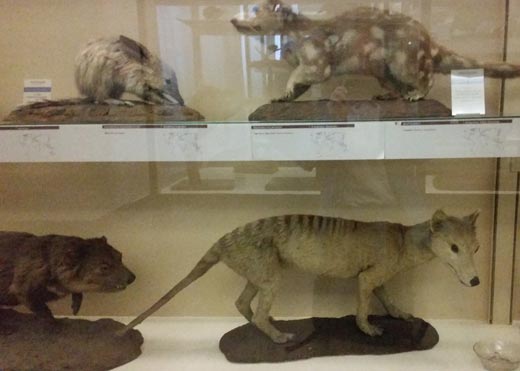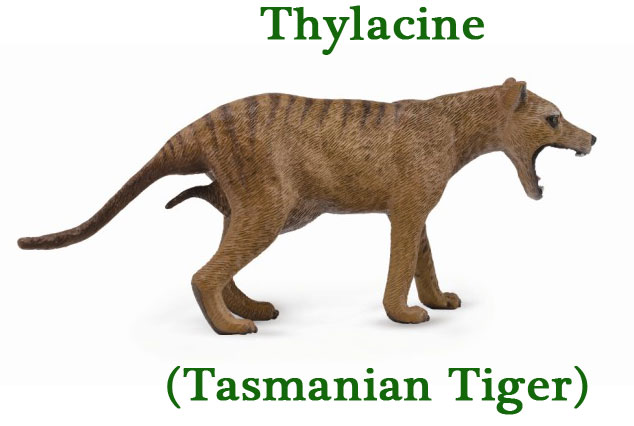Scientists Prepare to Set Camera Traps in Hunt for Thylacine
Ever since the last known Thylacine died in Hobart zoo back in 1936, there have been numerous “sightings” both in Tasmania and on the Australian mainland of this marsupial, frequently referred to as the “Tasmanian Tiger”. Most of these reports have been dismissed either as hoaxes, or as observers mistaking foxes or feral dogs for the largest carnivorous marsupial known to have co-existed with modern man during the Holocene Epoch.
Grainy photographs and blurred film footage have come to prominence from time to time, helping to fuel the debate as to whether Thylacines (Thylacinus cynocephalus), which were believed to have been hunted to extinction, might just have survived, with a few scattered populations holding on.
A Stuffed Thylacine (Thylacinus cynocephalus) in a Museum
Picture credit: Everything Dinosaur.
To view the range of CollectA models: CollectA Age of Dinosaurs Popular Models.
Scientific Expedition to a Remote Location in Northern Queensland
A field team will be dispatched to the remote Cape York Peninsula (northern Queensland), in a bid to search for evidence of the existence of a surviving Thylacine population. The team, led by Professor Bill Laurance of James Cook University (Queensland), hope to set fifty camera traps in the area so that photographic proof can be established. The Cape York Peninsula has been chosen as a number of credible witness accounts of possible sightings, including one from a tourism operator and former park ranger, have occurred in the locality.
Professor Laurance commented:
“All observations of putative Thylacines to date have been at night, and in one case four animals were observed at close range, about 20 feet away, with a spotlight. We have cross-checked the descriptions we received of eye shine colour, body size and shape, animal behaviour, and other attributes, and these are inconsistent with known attributes of other large-bodied species in north Queensland such as dingoes, wild dogs or feral pigs.”
The exact destination of the field team is being kept a closely guarded secret. Nearly four thousand reported sightings have been recorded on the Australian mainland, it is the reports from qualified rangers, Aboriginal communities and the many credible witnesses that offer the tantalising prospect of a live population being identified.
Ranger Patrick Shears, explained that local Aboriginals call the beast the “moonlight tiger” and that many observers claim that these marsupials approach quite close, before turning their long, stiff tails and trotting away into the darkness.
A Reward Offered for a Living Thylacine
Tasmanian tour operator Stuart Malcolm has offered an $1.75 million AUD (£1 million GBP), reward for proof that the Thylacine has survived to the present day. Professor Laurance and his team are not interested in any reward money, after all, it was a bounty placed on each dead Thylacine recorded, that helped devastate the species in Tasmania.
The Professor is not particularly sanguine when it comes to the chances of the expedition being a success. He has stated that it is very unlikely that the Thylacine has survived on the Australian mainland. However, with a number of credible reports to guide them, it seems that if the Tasmanian Tiger has survived anywhere on the mainland of Australia, the Cape York Peninsula is a good place to start looking.
CollectA introduced a finely detailed model of a female Thylacine into their model range last year. This model is quite hard to find, but not as difficult as a live Thylacine to track down. Everything Dinosaur stocks this model, for the CollectA Thylacine and other rare CollectA models: CollectA Prehistoric Life Figures.
The CollectA Prehistoric Life Thylacine Model
Everything Dinosaur intends to add a second Thylacine model to its already, extensive range later in the year. Check this blog for more details about the model and also for updates on the Queensland expedition.
Visit Everything Dinosaur’s award-winning website: Everything Dinosaur.








Leave A Comment